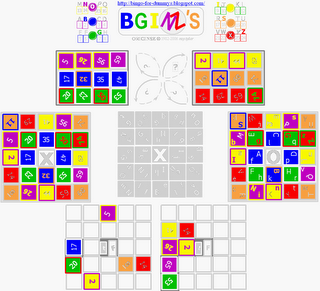
The principle of the original PACHISI (meaning 25), was an exploration of arithmetic properties which led to the discovery of zero. In turn this can be shown to relate to the special case Nasik Magic Square and its geometric principle of recursion, as being the quantum leap from arithmetic to geometric properties, (with its corollary trigonometric and algebraic features) the elements common to Chaturanga (quadripartite-division into four) the earliest known pre-cursor of Chess, which was clearly a 4-player game. ‘B’ 1-15; ‘I’ 16-30; ‘N’ 31-45; ‘G’ 46-60; the ‘O’ 61-75
Five random values are selected from each successive set of fifteen, but the central X is given no value there are only 4 selected. This ‘ideal average’ BINGO card has been divided into 4 geometric sets: 2 cardinal directions, blue & yellow; 2 sub-cardinal directions, green & orange, and a 5th set split into 2 approximate sub-sub-cardinal axes, violet & red. Chess players will recognize these as the two symmetries of the Knight’s move which are 4.065 degrees plus/minus the 1/16 divisions of a circle. Actually these five FUNCTIONAL sets represent displacement from the center which are the basic primordial movements of the earliest precursors of Chess. The BINGO numbers are Nominal numbers, in effect ‘named’ or identified as 24 values out 75 possible, having no significance in themselves. Any number of multiple sets of incremental (not necessarily sequential) values could be used.
The concept of ‘Ordinal’ or ‘ranking’ values of these cardinal value (nominals) is the critical feature which permits turning BINGO into an actual game/puzzle. Looking from the conventional South to North viewpoint the 5 random values from each successive column (West to East) may be ranked: ascending or descending.
By defining these as the Tabular ordinals (like a table of values), we can also view them as being isomorphic (one-on-one) within each of the six directional groups i.e. defining them as having corresponding Functional (geometric positioned) ordinal values.
To make this concept manageable an adaptation of the alphabet, excluding O&X (24 letters as in Greek alphabet) where the lower case letters are used for tabulars [t], and upper case letters for the functionals [F] is introduced to permit further exploration.
The initial random BINGO card used to generate successive pairs of clones: (each is a dummY) through a simultaneous exchange between the pairs of Functional &Tabular ordinal alpha-numeric values. The determination of the scoring sequence[s] in this BINGO-for-dummY’s allows for a surprising play challenge for 2 to ‘n’ players where imagination, mathematical skill, and judicial risk-taking form the solution approaches. It remains to discover if there are transferable real world applications related to finding the number of stages in its cycle where its extrapolation is analogous to the binary tree generation of ‘cellular automata’. An intriguing game theme is to further identify the synchronous patterns & sequences of the Ordinal sets which sum to the same perfect value – equal to 75.
The full development of the ‘bingo-for-dummY’s’ concept BGINSZ with a random scrambled BINGO card and the introduction of its 4 points-of-view. A special tiling set has been designed which leads to mosaics of melody, once the chromatic musical scale is introduced. The Harmonics become a portal to the ORIGINSZ © rt system of creative gaming using a universal language beyond words and the mumbo-jumbo of religions and political dogmas which may unite all peoples to share in a true universal experience of ‘order in space’
